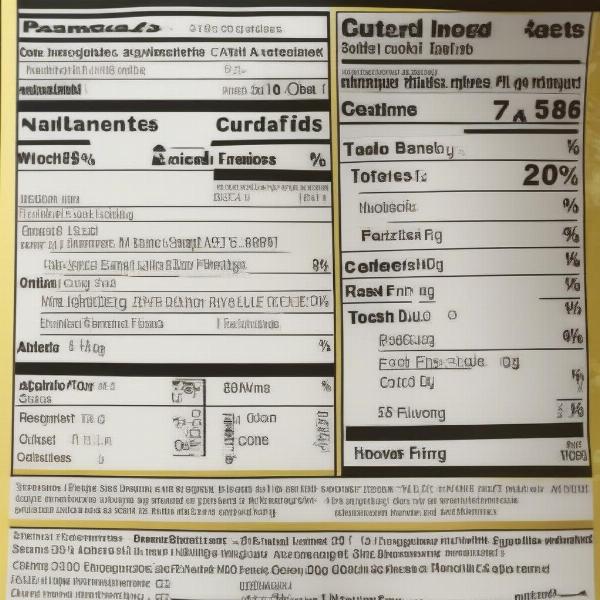Happy dog food isn’t just about a catchy name; it’s about providing your furry friend with the nutrition they need to thrive. Choosing the right food is a crucial part of responsible dog ownership, impacting everything from their energy levels and coat health to their overall well-being. Whether you’re a new dog owner or a seasoned pro, this comprehensive guide will help you navigate the world of happy dog food and make informed choices for your beloved companion.
Understanding Your Dog’s Nutritional Needs
Just like humans, dogs require a balanced diet to stay healthy. This means ensuring they receive the right proportions of proteins, fats, carbohydrates, vitamins, and minerals. However, a dog’s specific nutritional requirements vary depending on factors like their breed, age, activity level, and any underlying health conditions. For example, a highly active working dog will need a higher calorie and protein intake than a senior dog with a more sedentary lifestyle.
Understanding these individual needs is key to selecting a happy dog food that supports their optimal health and happiness. Consulting with your veterinarian can be particularly helpful in determining the best dietary approach for your dog. They can assess your dog’s individual needs and recommend appropriate food choices based on their specific circumstances.
Decoding Dog Food Labels
Navigating the vast array of dog food options can be overwhelming. Understanding dog food labels is crucial for making informed decisions. The information on the label provides valuable insights into the food’s ingredients, nutritional content, and suitability for your dog. Pay close attention to the guaranteed analysis, which lists the minimum percentages of crude protein, fat, fiber, and moisture.
 Close-up of a dog food label showing the ingredient list
Close-up of a dog food label showing the ingredient list
Also, examine the ingredient list, which is listed in descending order by weight. Look for whole meat sources as the primary ingredients, avoiding fillers and artificial additives. Consider your dog’s age and breed-specific needs. Puppy food, for example, is formulated with higher levels of protein and calcium to support growth, while senior dog food often contains fewer calories and added joint support supplements.
Types of Happy Dog Food
From kibble to canned food, raw diets to homemade meals, there are various options to choose from. Each type has its own pros and cons, and the best choice for your dog will depend on their individual preferences, dietary needs, and your lifestyle. Kibble is a popular choice due to its convenience and affordability. Canned food offers higher moisture content, which can be beneficial for dogs who don’t drink enough water.
Raw diets, while gaining popularity, require careful planning and preparation to ensure nutritional balance and avoid potential health risks. Homemade meals offer complete control over ingredients but also require careful balancing to meet your dog’s nutritional needs. satiety food for dogs and happy dog raw food are options that offer specific benefits. Choosing the best option for your dog can significantly contribute to their overall happiness and well-being.
Transitioning to a New Happy Dog Food
Switching your dog to a new food should be done gradually to avoid digestive upset. Start by mixing a small amount of the new food with their current food, gradually increasing the proportion of new food over several days. Monitor your dog closely for any signs of digestive issues, such as vomiting or diarrhea, and adjust the transition period as needed. satiety dog food can be a great option for dogs who struggle with maintaining a healthy weight. For other breeds, such as pitbulls, specialized diets like the ones discussed in best dog food pitbulls might be more suitable. happy dog pet food offers a wide range of options for different breeds and life stages.
Conclusion
Choosing a happy dog food is a significant decision that directly impacts your furry friend’s health and happiness. By understanding your dog’s individual needs, decoding food labels, and considering the various types of food available, you can make informed choices that support their overall well-being. Remember, a happy dog starts with a healthy diet!
FAQ
- What are the essential nutrients in happy dog food? A balanced diet should include proteins, fats, carbohydrates, vitamins, and minerals.
- How do I choose the right food for my dog’s age and breed? Consider factors like age, breed size, activity level, and any health conditions. Consult with your vet for personalized recommendations.
- What is the best way to transition my dog to a new food? Gradually introduce the new food over several days, mixing it with their current food.
- What are the signs of a food allergy in dogs? Symptoms can include itching, skin rashes, digestive upset, and ear infections.
- How often should I feed my dog? Feeding frequency depends on factors like age, activity level, and the type of food. Consult your vet for guidance.
- Is homemade dog food a good option? It can be, but requires careful planning to ensure nutritional balance.
- What should I do if my dog refuses to eat their new food? Try different flavors or textures, or consult with your vet.
ILM Dog is your trusted resource for all things dog-related. From breed selection and health care to training and nutrition, we’re here to help you navigate every aspect of dog ownership. Our expert advice and practical tips will empower you to make informed decisions that contribute to your dog’s happiness and well-being. We specialize in dog breeds, health, training, nutrition, grooming, and provide a wide range of products and accessories to meet your dog’s every need. For more information, contact us at [email protected] or call us at +44 20-3965-8624. Visit ILM Dog today for personalized guidance and support on your dog parenting journey.